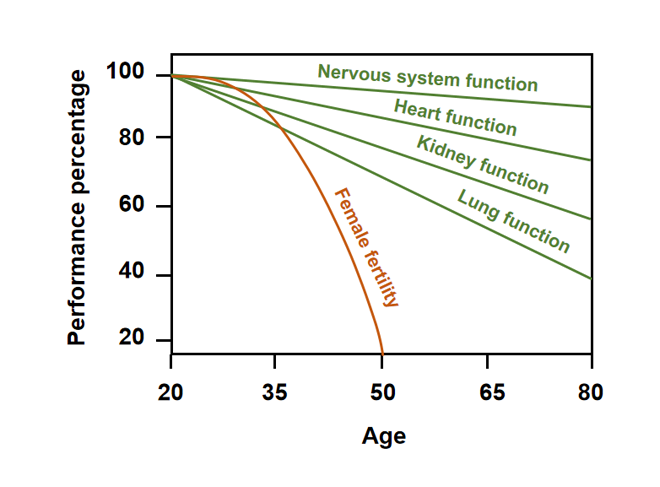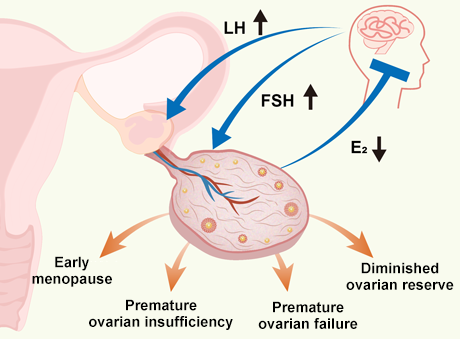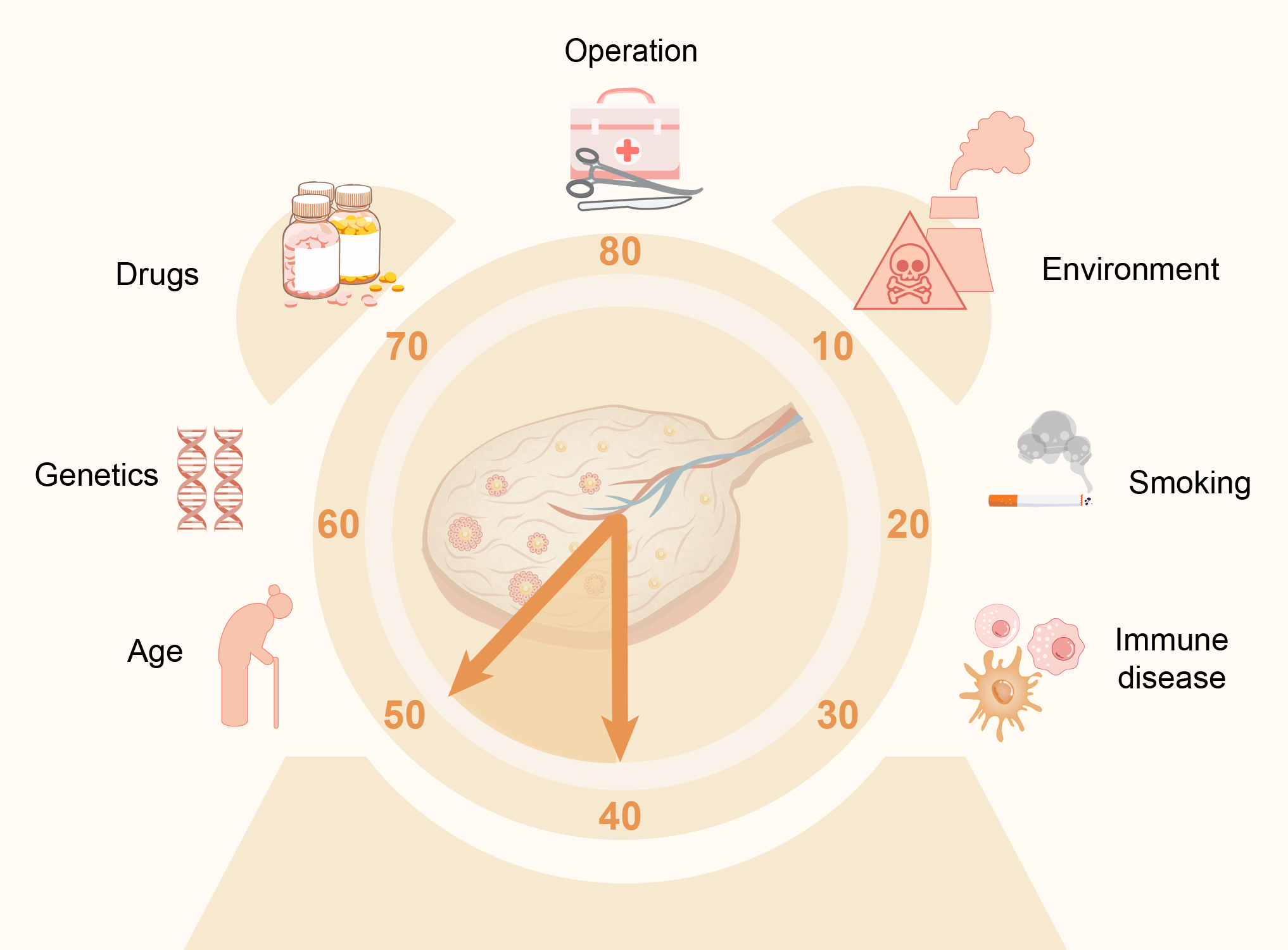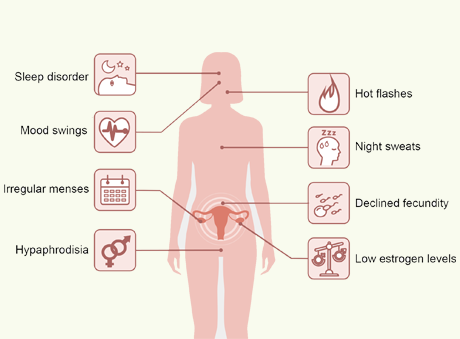Background
The ovary is one of the first organs to age in humans.
With advancing age, women experience a progressive decline in ovarian function, characterized by diminished ovarian reserve and reduced reproductive capacity. While fertility potential peaks in the early 20s, a substantial reduction in fertility is observed after 37-38 years of age. Menopause is the ultimate manifestation of ovarian aging, with the age at natural menopause occurring between 50 and 51 years.

Ovarian reserve
The primordial follicle, consisting of a primary oocyte in the meiotic diploid phase enveloped by a single layer of granulosa cells, represents the fundamental reproductive unit in females. Following embryonic development, follicles embark on an irreversible trajectory of either development or atresia. From puberty onwards, these follicles continuously undergo recruitment, ovulation or atresia. Throughout a woman's reproductive lifespan, only 400 to 500 follicles achieve full maturation and subsequent ovulation. By approximately age 50, the inadequate ovarian reserve could not sustain regular menstrual cycles, ultimately leading to menopause. A small primordial follicle pool, accelerated follicle depletion, or impaired follicular follicular function can lead to ovarian insufficiency or failure, manifesting as ovarian aging.

Ovarian Aging-Related Pathologies
Early Menopause, EM
EM is defined as the onset of menopause occurring between 40 and 44 years of age. EM is considered as an intermediate status between premature ovarian insufficiency and natural menopause. With a global prevalence of around 12%, this condition exerts substantial long-term impacts on women's reproductive capacity and psychological health.
Premature Ovarian Insufficiency, POl POI refers to the decline or cessation of ovarian function before the age of 40, characterized by menstrual irregularities (amenorrhea or oligomenorrhea), reduced fertility, elevated FSH levels, and decreased estrogen production. POI represents a spectrum of ovarian dysfunction affecting approximately 3.5% of the population. Distinct from natural menopause, 5-10% of affected individuals achieves natural pregnancies.
Premature Ovarian Failure, POF POF refers to cessation of ovarian function prior to the age of 40, characterized by amenorrhea, elevated FSH levels above 40 IU/L, reduced estrogen concentrations, and various perimenopausal symptoms. POF represents the final stage of POI.
Diminished Ovarian Reserve, DOR DOR is defined as a decrease in the quantity or quality of oocytes, accompanied by diminished anti-Müllerian hormone (AMH) levels, reduced antral follicle counts (AFC), and elevated FSH levels. DOR represents a state of compromised reproductive potential, independent of age, underlying etiology, or menstrual cycle alterations.
Premature Ovarian Insufficiency, POl POI refers to the decline or cessation of ovarian function before the age of 40, characterized by menstrual irregularities (amenorrhea or oligomenorrhea), reduced fertility, elevated FSH levels, and decreased estrogen production. POI represents a spectrum of ovarian dysfunction affecting approximately 3.5% of the population. Distinct from natural menopause, 5-10% of affected individuals achieves natural pregnancies.
Premature Ovarian Failure, POF POF refers to cessation of ovarian function prior to the age of 40, characterized by amenorrhea, elevated FSH levels above 40 IU/L, reduced estrogen concentrations, and various perimenopausal symptoms. POF represents the final stage of POI.
Diminished Ovarian Reserve, DOR DOR is defined as a decrease in the quantity or quality of oocytes, accompanied by diminished anti-Müllerian hormone (AMH) levels, reduced antral follicle counts (AFC), and elevated FSH levels. DOR represents a state of compromised reproductive potential, independent of age, underlying etiology, or menstrual cycle alterations.


Causes of Ovarian Aging
The etiology of pathological ovarian aging is highly heterogeneous. Any factors resulting in a small primordial follicle pool, accelerated follicle depletion, or follicle dysfunction, can lead to ovarian insufficiency or failure, resulting in ovarian aging.





Genetic factors
Chromosomal abnormalities or genetic mutations
Iatrogenic factors
Oophorectomy or pelvic surgeries, immunosuppressant use, chemotherapy, or pelvic radiotherapy
Immune factors
Concomitant autoimmune diseases (autoimmune thyroid disease and Addison's disease), and cellular immune imbalance
Environmental and other factors
Smoking or passive smoking, long-term use of gonadal toxic drugs, environmental toxicants, endocrine disruptors, such as organic solvents, pesticides, plasticizers, industrial chemicals, etc.
Idiopathic factors
The exact causes for most POI patients remain unknown.
Symptoms of Ovarian Aging
Irregular menses or amenorrhea
Subfertility or infertility
Hypoestrogenic symptomsVasomotor symptoms (night sweats, hot flashes), sleep disorder, mood swings, vaginal dryness, hypaphrodisia, osteoporosis, etc.
Long-term complicationsCardiovascular diseases, neurological diseases, etc.
